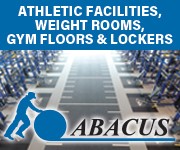In an increasingly competitive higher-education landscape, colleges and universities must consider a variety of design elements–like tile and flooring—to help create more attractive and more productive spaces for a promising student body. Read on for an overview of commonly specified materials and recommended flooring and tile installation products for higher education facilities.
Flooring Installation Trends: Materials
Carpet: Glue-down carpet is solidly supported with minimal movement. It works well for rolling traffic and is suitable for ramps. It also creates a less challenging transition from carpet to hard surfaces, reducing the risk of tripping, which is essential in busy educational facilities. Carpet tile allows for unique designs, with lots of school spirit. And, it provides an advantage for especially high-traffic areas. “Ugly-ing out” occurs when a carpet’s “traffic lane”–a frequently traversed area–shows signs of wear after repeated foot traffic. In cases like this, carpet tile can be easily replaced, without disrupting student life. Carpet tile can be used to form elaborate designs with lots of school spirit. Carpet also offers a sense of comfort–particularly in residence halls–and reduces heating costs.
Vinyl Composition Tile: Vinyl composition tile is highly durable and often suited for high-traffic environments like those found on university campuses. It is available in a wide variety of colors, patterns, styles and finishes. Vinyl composition tile should be sealed and waxed to elevate chemical and stain-resistance
Luxury Vinyl Tile: Luxury vinyl tile now features 3-D printing technology – which allows manufacturers to effectively mimic the look of ceramic or wood floor at a lower price point. This can provide the high-end aesthetic that education stakeholders often desire. Luxury vinyl tile does not always need to be sealed and waxed, which means it requires less lifetime maintenance than vinyl composition tile. It can be easily grouted with vinyl tile grout, making it durable and wear resistant to foot traffic in high traffic areas like a student union.
Tile: Tile is often used in the “extra” facilities designed to recruit students. It offers a high-end aesthetic and emanates a sense of prestige. It can be used to enhance the appearance of swimming pools on college campuses–adding an accent with school spirit. It also provides great longevity and durability.
Many universities are focused on creating a state-of-the-art athletic facility to attract tudent athletes. At Michigan State University, for instance, their facility features a variety of tile types, including glass tile in the school’s colors. This university relied on tile to create a welcoming, yet elegant space that reflects MSU’s commitment to obtaining and recruiting successful student-athletes.
Other Considerations
Colleges and universities are increasingly highlighting their environmental responsibility in order to attract students. Look for flooring and tile installation products that can contribute to LEED® points to help win these types of projects. Regardless of material, colleges and universities don’t want their appearance marred by time-consuming installations. Read on for tips on fast-tracking school installations to learn how you can wrap up jobs fast.
How to Fast Track School Renovations
A new school year means one thing for commercial contractors: school renovations. These renovations have a hard deadline. (After all, the school year will start as scheduled, whether you’re ready or not). Not only that, school districts often have a hard budget, and can’t afford for your flooring installation to take longer than expected. Follow these steps to keep your school installation on schedule:
1. Efficient moisture mitigation:
Moisture testing is best practice for any flooring installation — from carpet to resilient. The ASTM F-2170 test is an accurate and efficient test. It provides a relatively rapid reading, so you can make mitigation decisions almost immediately. If mitigation is required and you want to finish your school flooring installation as efficiently as possible, use a product which exceeds the ASTM standard for moisture vapor barriers and is designed to reduce the MVER to less than 3 lbs. per 1000 ft. per 24 hours, or correct elevated Relative Humidity readings as high as 100% RH. Look for a one-step, single-coat application that does not require shot blasting over clean, sound concrete. You can install carpet after as few as five hours, to keep time-sensitive projects on track.
2. Immediate post-trenching mitigation
If simultaneous renovations are happening at the school, or if you’re working on a new build, other trades are probably performing trenching. Trenching is the act of encasing plumbing, gas or electrical lines within concrete. The cement that surrounds plumbing, gas or electrical lines typically takes a minimum of 28 days per first deep to cure. However, look for a product that can be applied as early as three-to-four days from the initial day of cement placement to accelerate your school flooring installation.
3. Rapid leveling:
Any floor covering used in a school — from carpet to terrazzo — will look and perform better if the surface is properly prepared. Seek out a product that is fast curing, walkable in 2-4 hours, and ready to install for permeable coverings in 6 hours and non-permeable coverings in 12-16 hours. Curing to walkable hardness rapidly is essential for school renovations, which often involve other trades. You don’t want to leave your installation unattended only to find out your hard work on surface preparation has been marred.
4. Fast-drying adhesives
Fast-curing adhesives are available for both floor covering products and tile. For floor covering installation, look for adhesives with a shorter open time and very aggressive grab to prevent the tiles from sliding when introduced to other trade traffic during the construction phase. For tile, opt for a fast-setting mortar.










